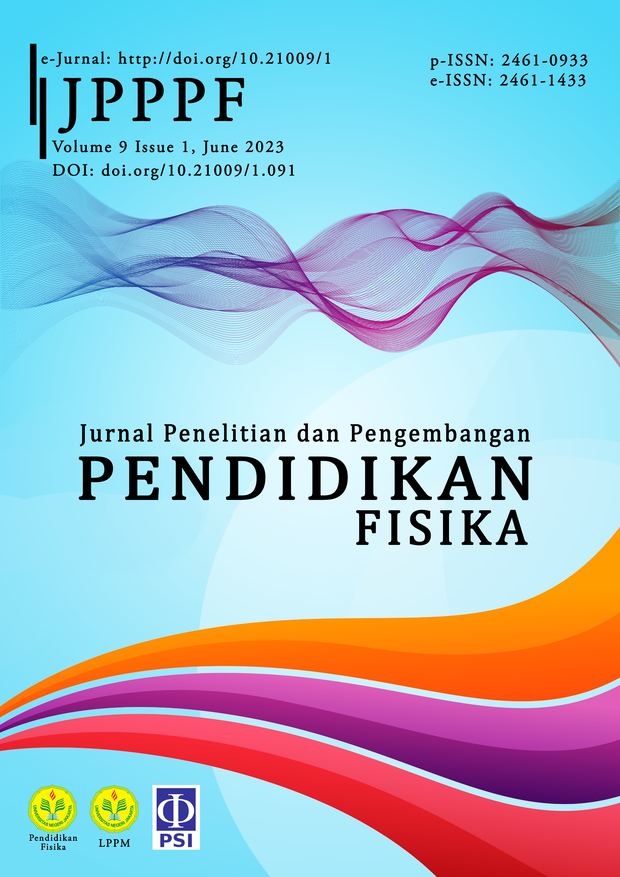The Development of STEM-Based Science Teaching Materials on Simple Electrical Circuit Materials
DOI:
https://doi.org/10.21009/1.09112Keywords:
teaching materials, STEM, simple electrical circuit materialsAbstract
This study aims to create STEM-based science teaching materials based on simple electrical circuits and determine the feasibility of STEM-based teaching materials. Research and development of the Dick & Carey model is the type of research used. The research process comprises four stages: needs analysis, product design, validation and evaluation, and testing. Material experts, presentation experts, linguists, and graphic experts are all involved in expert validation. Teachers who teach science subjects participate in the product feasibility test. Individual, small group, and field trials assess students’ readability. Expert validation revealed that the content aspect was 97.7 % with a very decent category, the presentation aspect was 97.7% with a very proper category, the language aspect was 85% with a very decent category, and the visual aspect was 80 percent with a worthy category. The science teacher’s feasibility test results showed that the content aspect was 90 % with an excellent category, the presentation aspect was 98.6% with an outstanding category, and the language aspect was 96.7% with a superior category. Students’ readability test results showed an average score of 87.7% in the excellent category. Based on the validation and legibility trials findings, developing STEM-based science teaching materials (Science, Technology, Engineering, and Mathematics) on simple electrical circuit materials is feasible. It can be used as a learning resource.
References
Astuti, NH, Rusilowati, A & Subali, B 2021, ‘STEM-Based Learning Analysis to Improve Students’ Problem Solving Abilities in Science Subject: a Literature Review’, Journal of Innovative Science Education, vol. 9, no. 3, pp. 79-86, doi: 10.15294/jise.v9i2.38505.
Becker, K & Park, K 2011, ‘Effects of integrative approaches among science, technology, engineering, and mathematics ( STEM ) subjects on students’ learning : A preliminary meta-analysis’, Journal of STEM Education, vol. 12, no. 5, pp. 23-38.
Bybee, R 2010, ‘What is STEM education?’, Science, vol. 329, no. 5995, p. 996, Available at: 10.1126/science.1194998.
Chiapetta, E & Koballa, T 2010, ‘Instruction in The Middle and Secondary School 7th Edition’, Boston: Allyn and Bacon.
Chingos, MM & Whitehurst, GJ 2012, ‘Choosing Blindly: Instructional Materials, Teacher Effectiveness, and the Common Core’, Brookings Institution.
Daryanto 2013, ‘Menyusun Modul: Bahan Ajar untuk Persiapan Guru dalam Mengajar’, Yokyakarta: Gava Media.
Habibi, M 2014, ‘Pengembangan Modul Pecahan Berbasis Konstruktivisme Dengansisipan Karikatur Untuk Kelas Iv Sekolah Dasar’, Prosiding Seminar Nasional Pendidikan Matematika, pp. 27-48, doi: 10.13140/RG.2.1.2175.7609.
Henukh, A et al. 2019, ‘Multimedia development based on web connected Massive Open Online Courses ( cMOOCs ) on the basic physics material Multimedia development based on web connected Massive Open Online Courses ( cMOOCs ) on the basic physics material’, IOP Conf. Series: Earth and Environmental Science, pp. 1-10, doi: 10.1088/1755-1315/343/1/012160.
Henukh, A et al. 2020, ‘Penilaian Formatif Berbasis Quizizz Pada Mata Kuliah Fisika Dasar Pada Masa Covid-19’, Musamus Journal of Science Education, vol. 3, no. 1, pp. 1-7, doi: 10.3572/mjose.v3i1.3515.
Henukh, A, Loupatty, M & Supriyadi 2022, ‘Pengembangan Bahan ajar Fluida Statis Terintegrasi Google Classroom untuk meningkatkan belajar Mandiri Peserta Didik’, Musamus Journal Science Education, vol. 4, no. 2, pp. 34-44.
Honey, MA, Pearson, G & Schweingruber, H 2014, ‘STEM integration in K-12 education: status, prospects, and an agenda for research, STEM Integration in K-12 Education: Status, Prospects, and an Agenda for Research, National Academies Press, doi: 10.17226/18612.
Izzuddin, A 2019, ‘Sains Dan Pembelajarannya Pada Anak Usia Dini’, Jurnal Pendidikan dan Sains, vol. 1, no. 3, pp. 353-365, Available at: https://ejournal.stitpn.ac.id/index.php/bintang.
Kesidou, S & Roseman, JE 2003, ‘Project 2061 analyses of middle-school science textbooks: A response to holliday’, Journal of Research in Science Teaching, vol. 40, no. 5, p. 535, doi: 10.1002/tea.10095.
Kesumawati, N 2014, ‘Pengembangan Bahan Ajar Interaktif Berbasis Komputer Pokok Bahasan Lingkaran Untuk Kelas VIII Sekolah Menengah Pertama’, Jurnal Pendidikan Matematika, vol. 8, no. 1, pp. 55-70.
Kumar, S 2017, ‘Teaching Materials and Teaching Aids - II’, Uttaranchal University, pp. 1-15.
Lestari, I 2013, ‘Pengembangan Bahan Ajar Berbasis Kompetensi: sesuai dengan Kurikulum Tingkat Satuan Pendidikan’, Padang: Akademia.
Nastiti, G & Hinduan, AA 2012, ‘Pembelajaran Ipa Model Integrated Untuk Meningkatkan Motivasi Dan Hasil Belajar Pada Pokok Bahasan Energi Di Smp Negeri Purworejo, Jawa Tengah’, Berkala Fisika Indonesia, vol. 4, no. 1-2, pp. 1-10.
Shepa, J & Uskenat, K 2021, ‘Pengaruh Gaya Kognitif Terhadap Hasil Belajar dengan Menerapkan Model Pembelajaran Berdasarkan Masalah’, Magnetic: Research Journal of Physics and It’s Application, vol. 1, no. 1, pp. 34-39.
Shernoff, DJ et al. 2017, ‘Assessing teacher education and professional development needs for the implementation of integrated approaches to STEM education’, International Journal of STEM Education, vol. 4, no. 1, pp. 1-16, doi: 10.1186/s40594-017-0068-1.
Trianto 2011, ‘Pengantar Penelitian Pendidikan bagi Pengembangan Profesi Pendidikan dan Tenaga Kependidikan’, Jakarta: KENCANA PRENADA MEDIA GROUP.
Trianto 2017, ‘Mendesain Model Pembelajaran Inovatif, Progresif dan Konstekstual’, Prenada Media.
Uskenat, K, Iswanto, BH & Indrasari, W 2021, ‘Spring oscillator as case based learning (CBL) device’, Journal of Physics: Conference Series, vol. 1806, no. 1, p. 012008, doi: 10.1088/1742-6596/1806/1/012008.
Wang, HH et al. 2020, ‘Defining interdisciplinary collaboration based on high school teachers’ beliefs and practices of STEM integration using a complex designed system’, International Journal of STEM Education, vol. 7, no. 1, pp. 1-17, doi: 10.1186/s40594-019-0201-4.
Yuanita, Y & Kurnia, F 2019, ‘Pengembangan Bahan Ajar Berbasis Stem (Science, Technology, Engineering, and Mathematics) Materi Kelistrikan Untuk Sekolah Dasar’, Profesi Pendidikan Dasar, vol. 6, no. 2, pp. 199-210, doi: 10.23917/ppd.v1i2.9046.
Yuliani, Cahyani, D & Roviati, E 2016, ‘Penerapan Pembelajaran Ipa Berbasis Keterampilan Proses Sains Untuk Meningkatkan Literasi Sains Pada Mata Pelajaran Ipa Di Kelas Vii Materi Pokok Pencemaran Lingkungan Di Smpn 1 Cikijing’, Jurnal Sains dan Pendidikan Sains, Pd.I; Jurusan Tadris IPA Biologi Jalan Perjuangan Bypass Sunyaragi Cirebon, vol. 5, no. 2, pp. 122-135, Available at: www.syekhnurjati.ac.di/jurnal/index.php/sceducatia.











